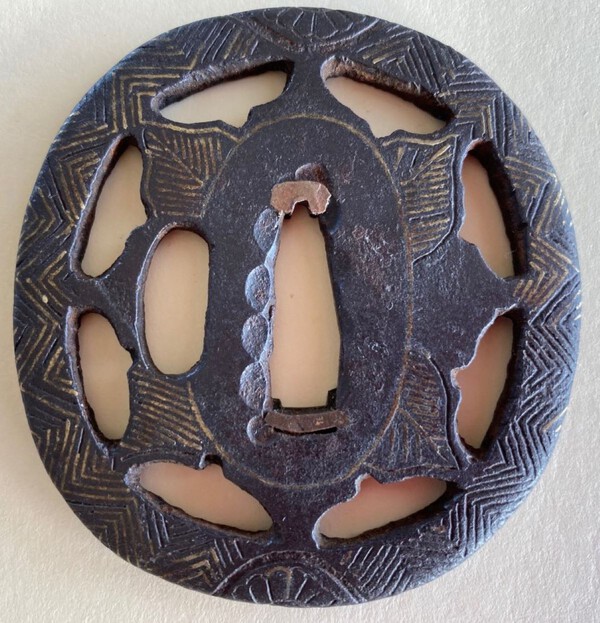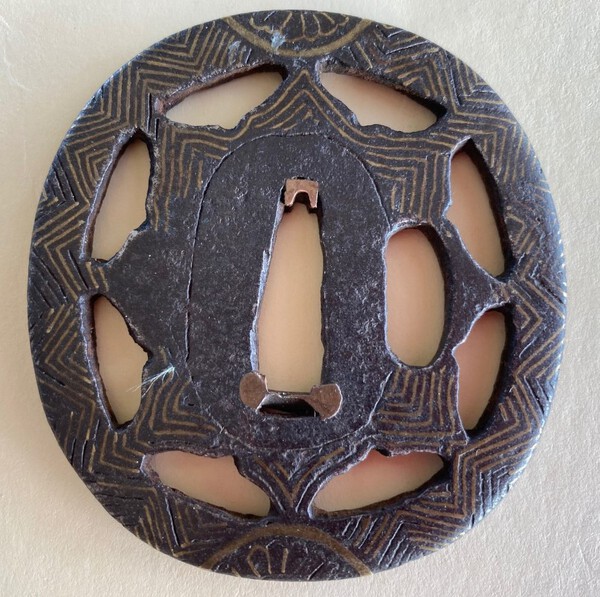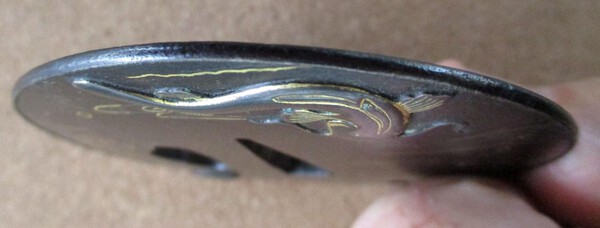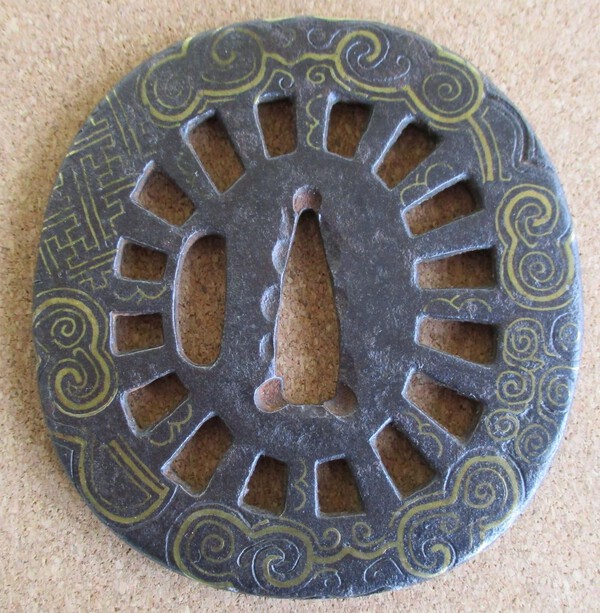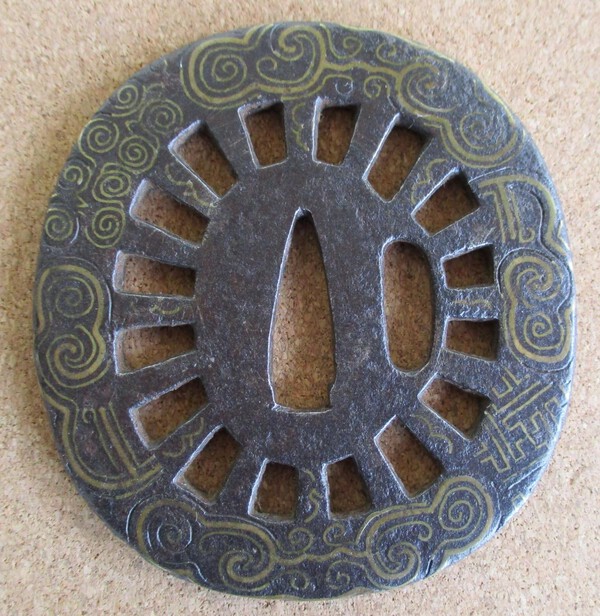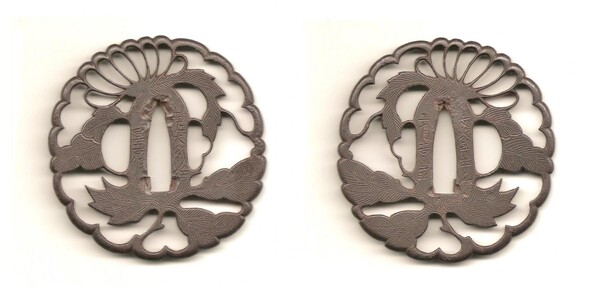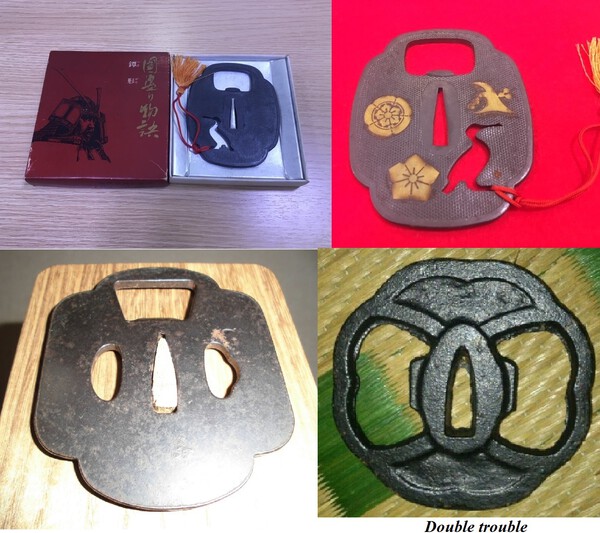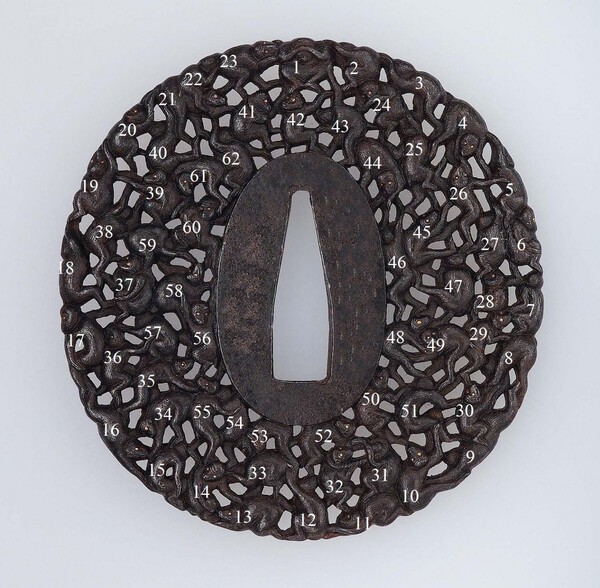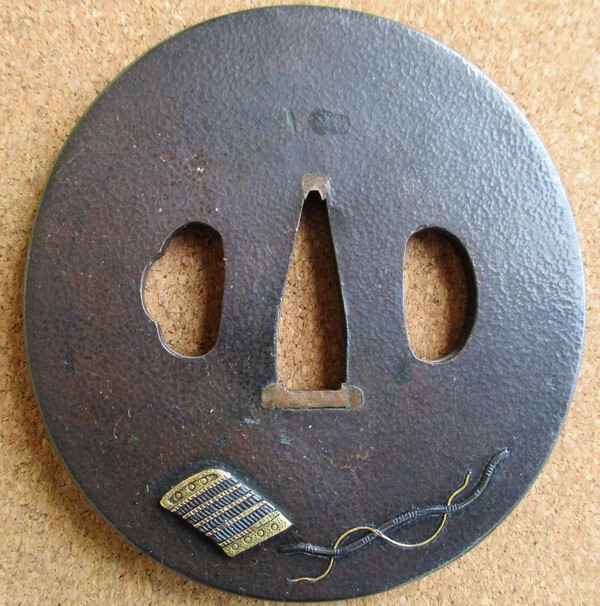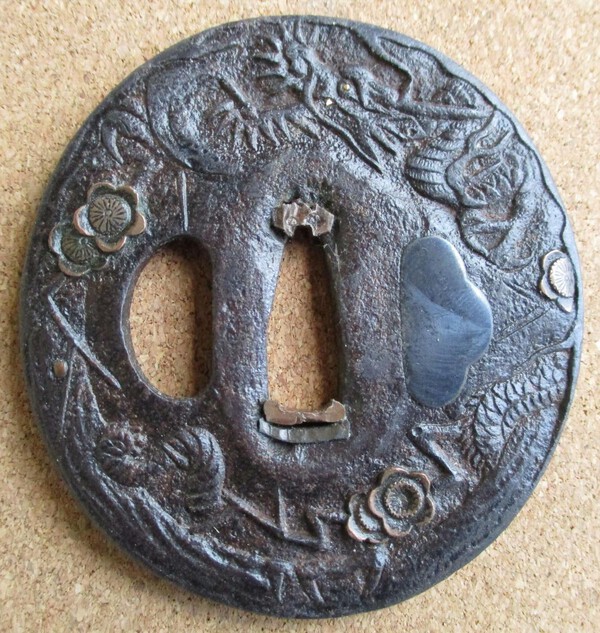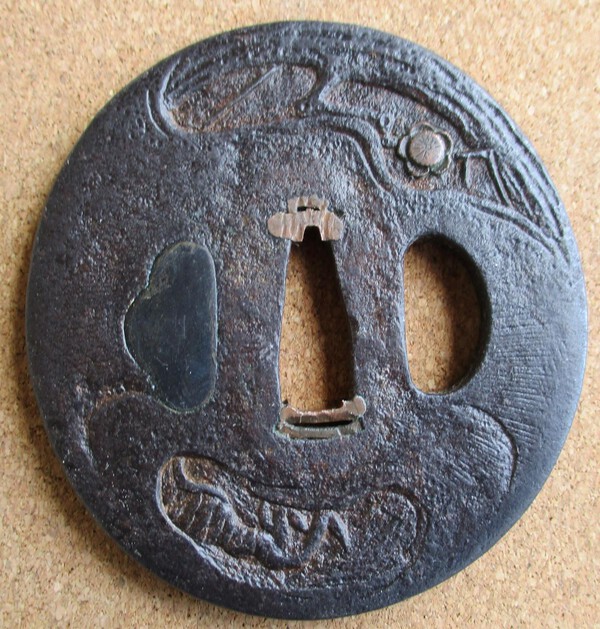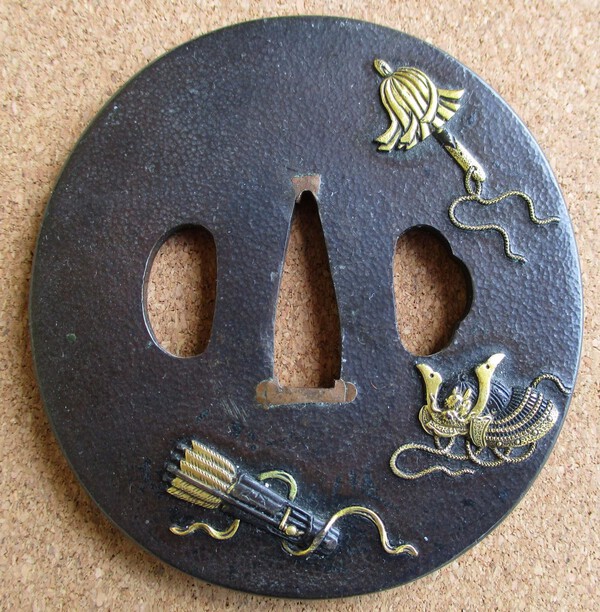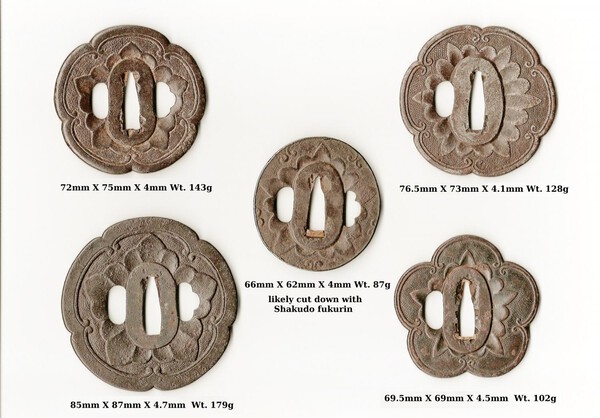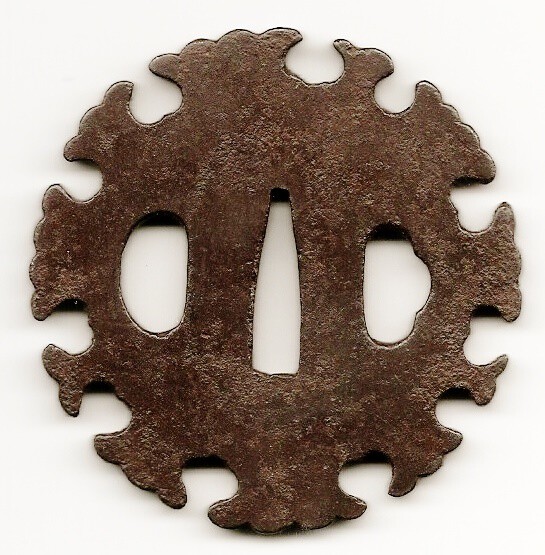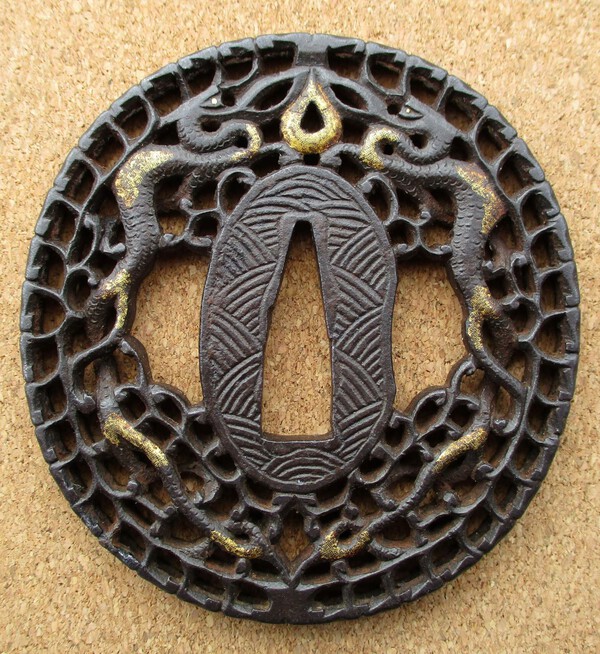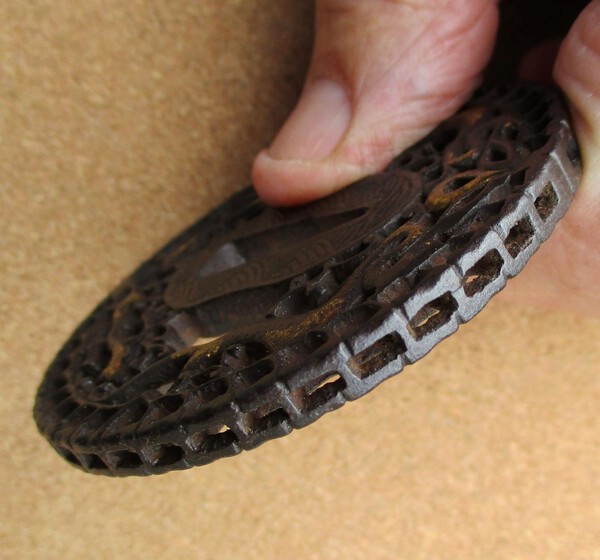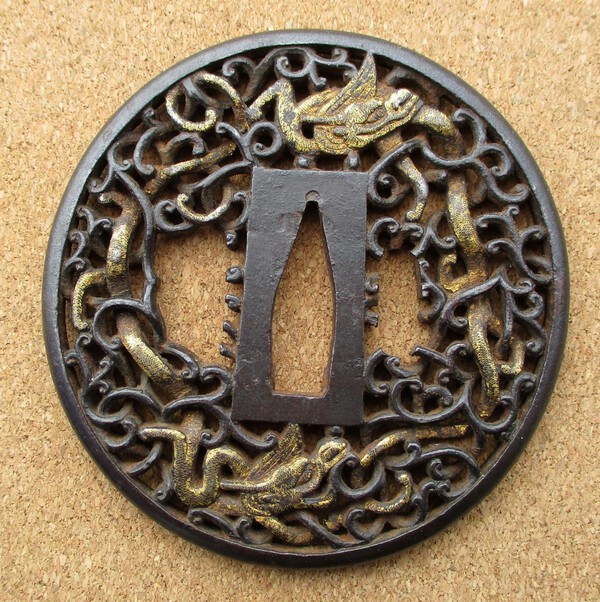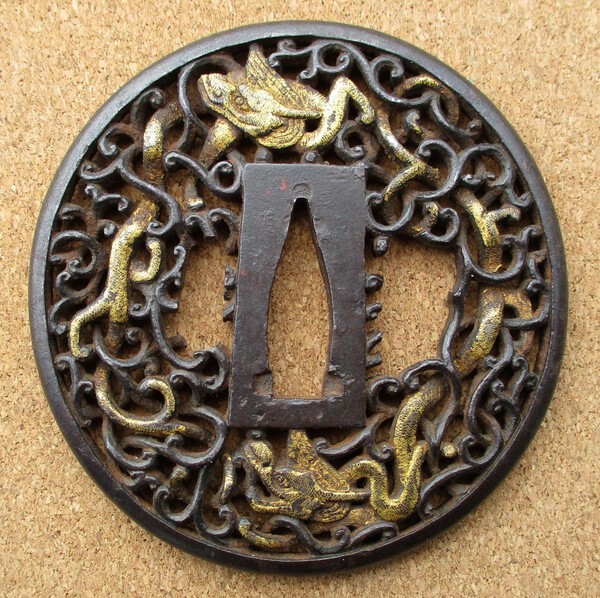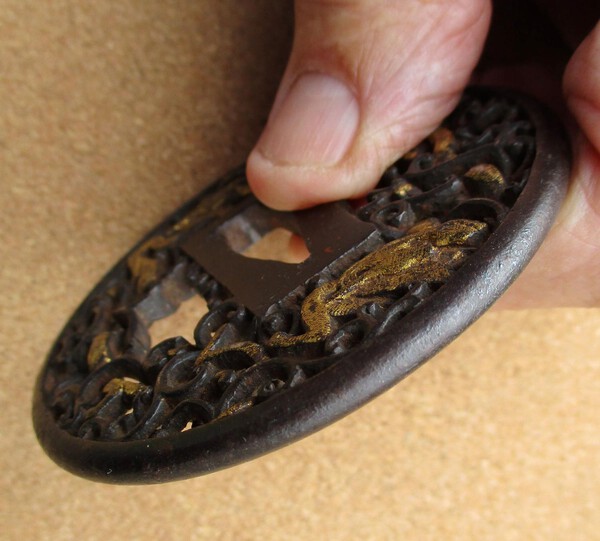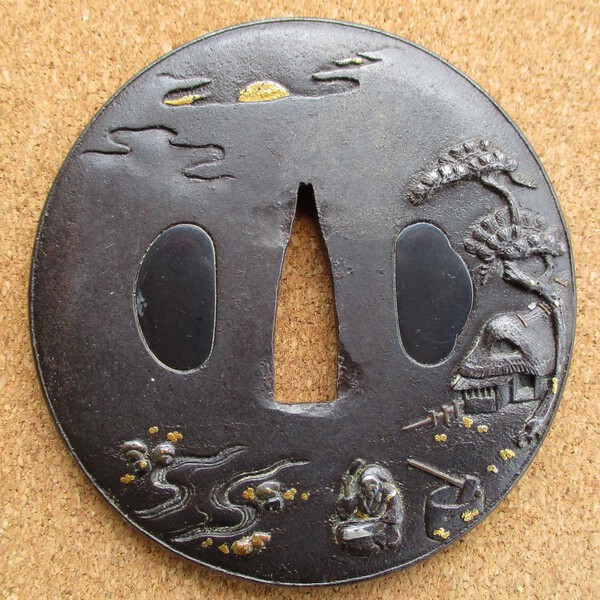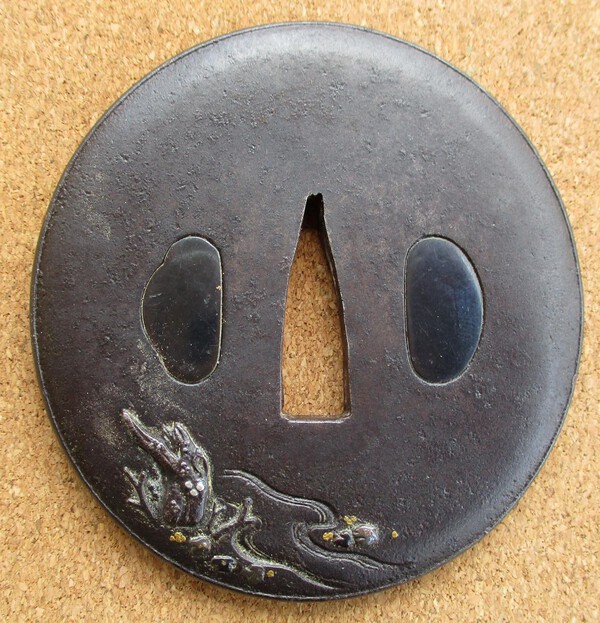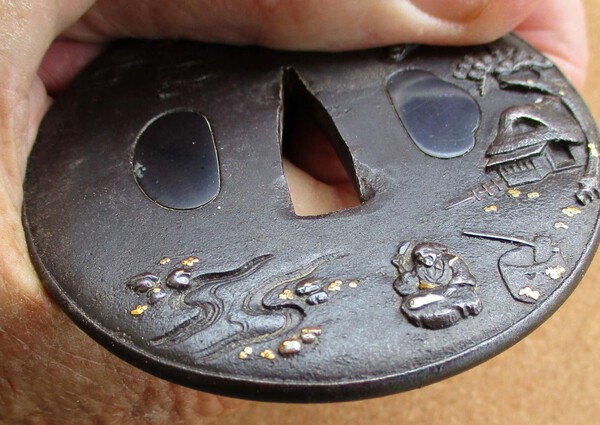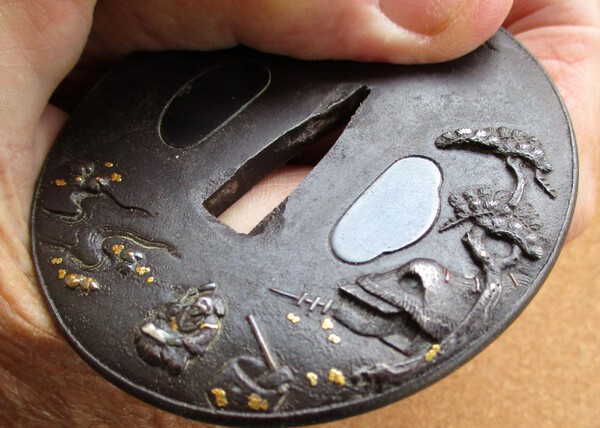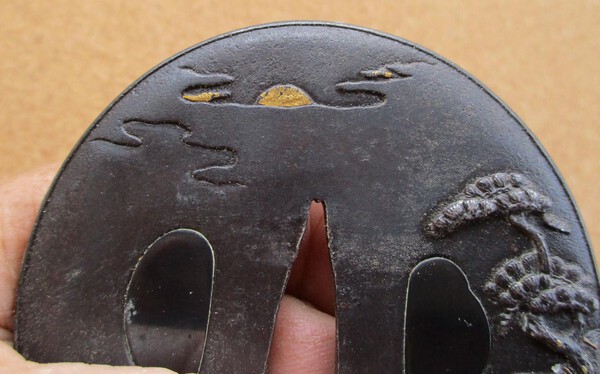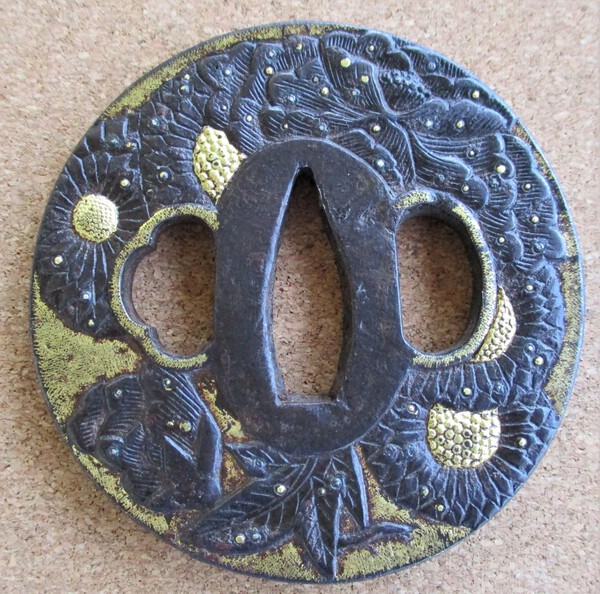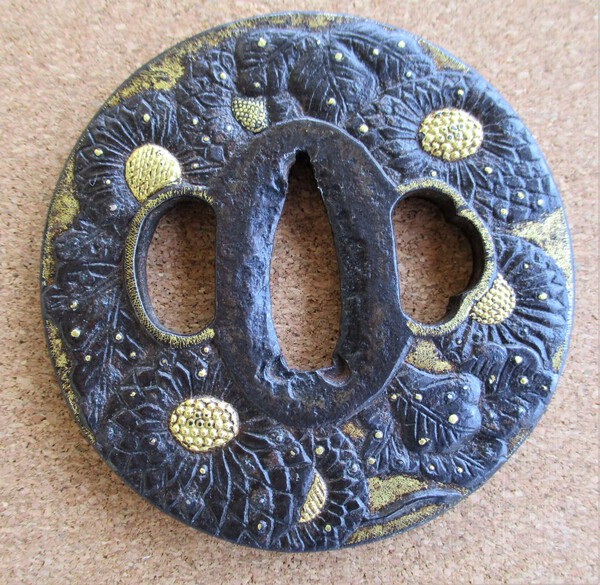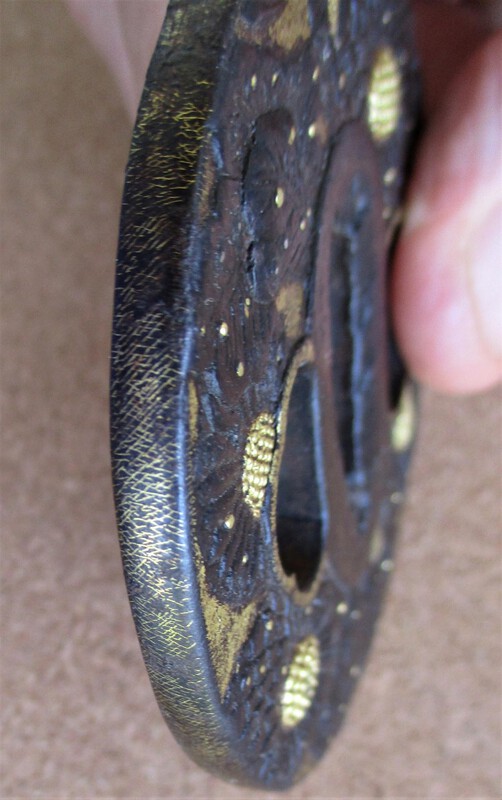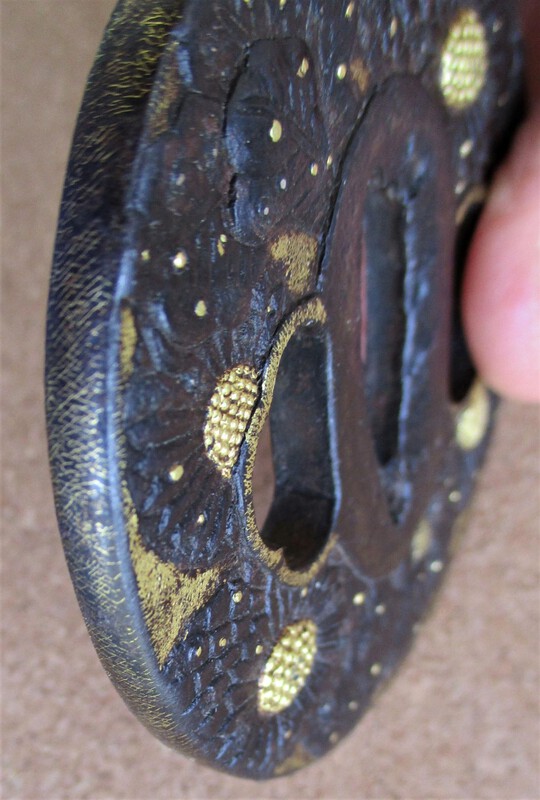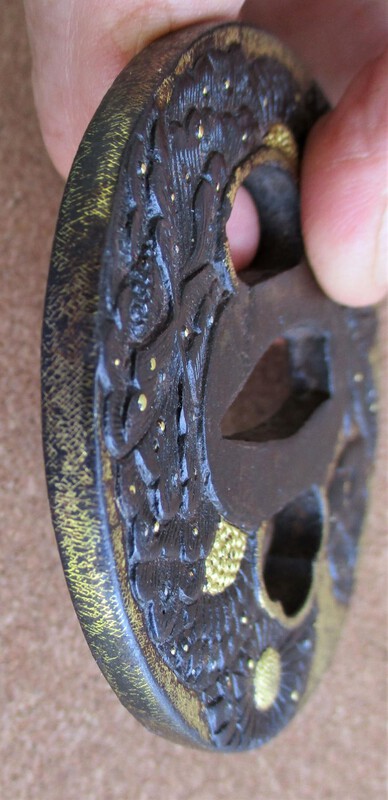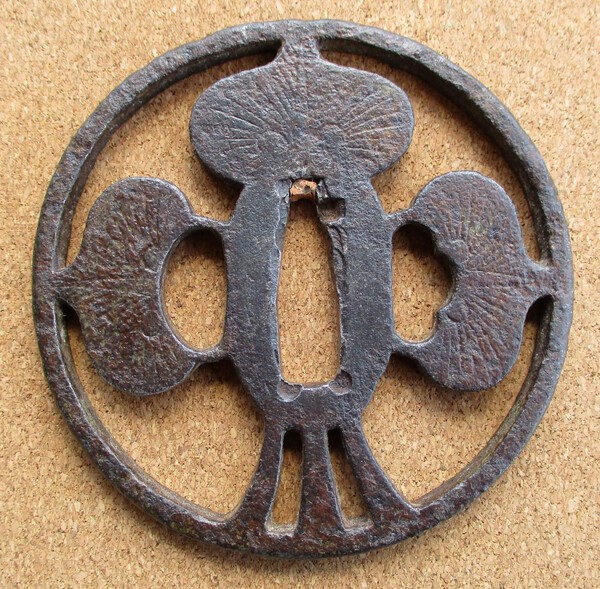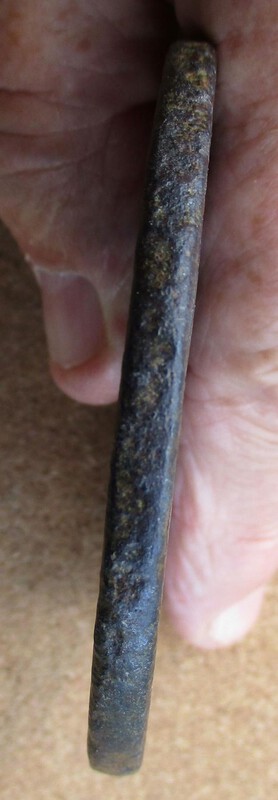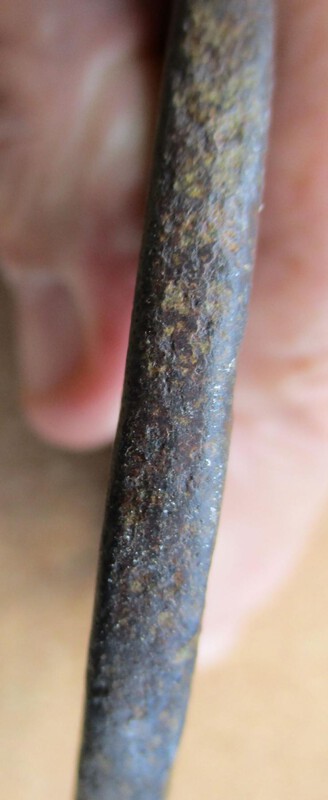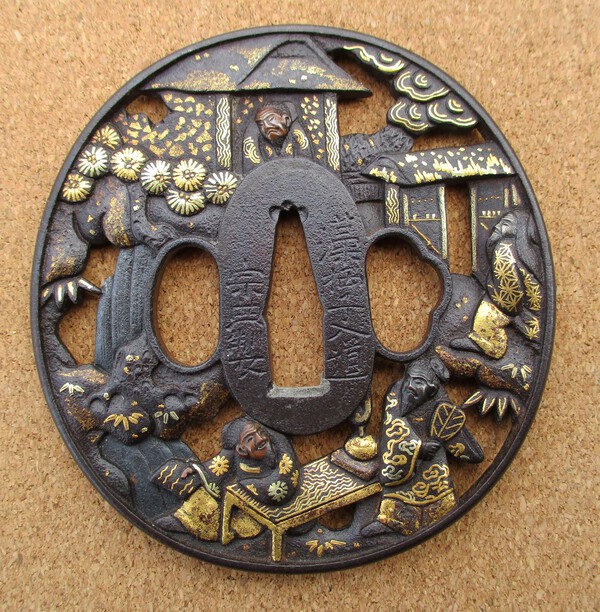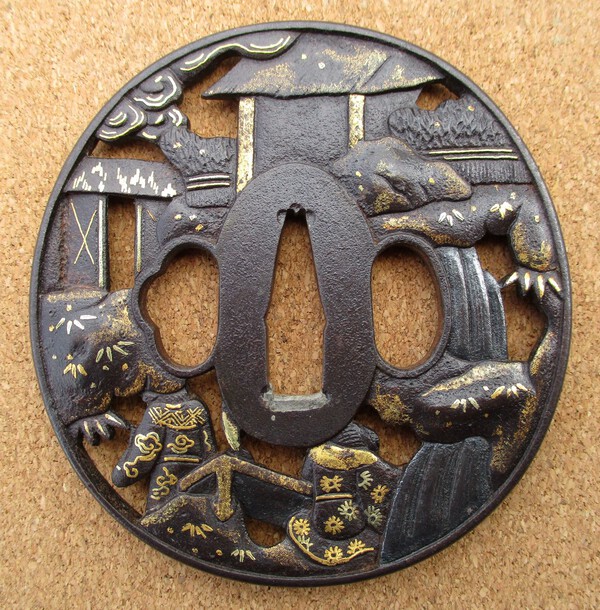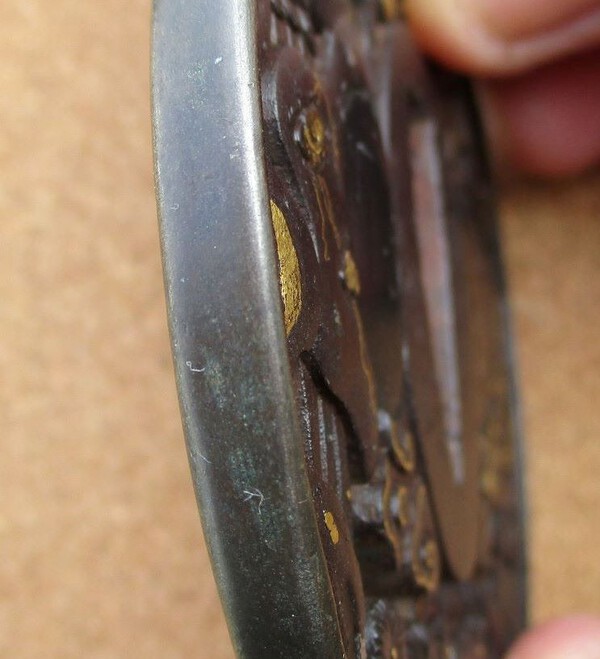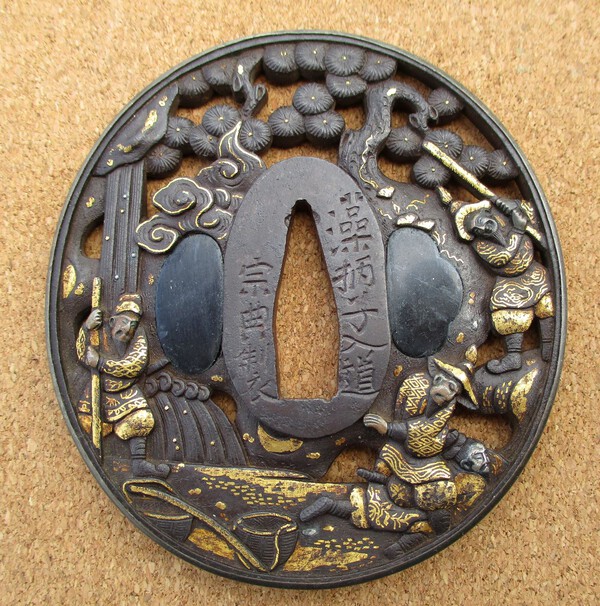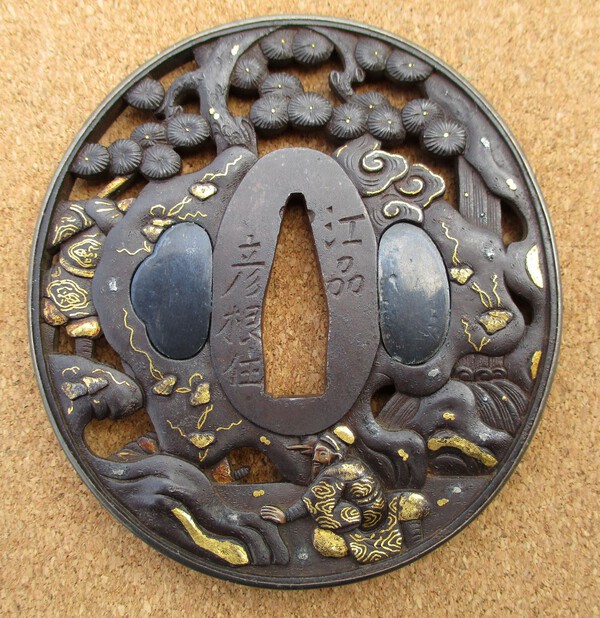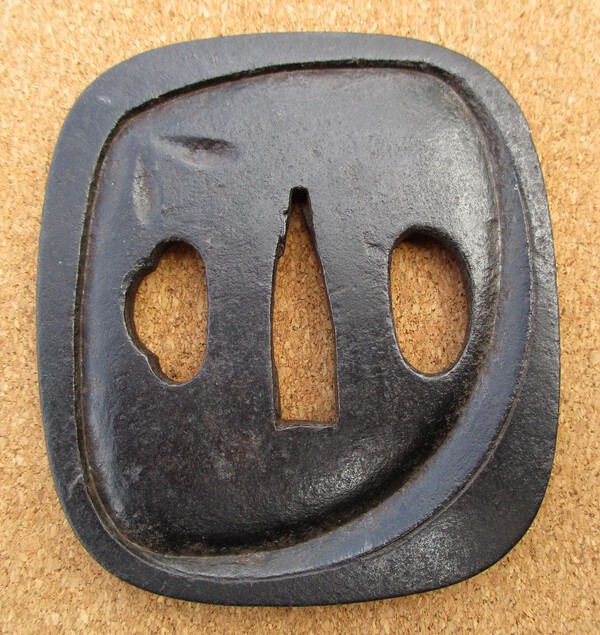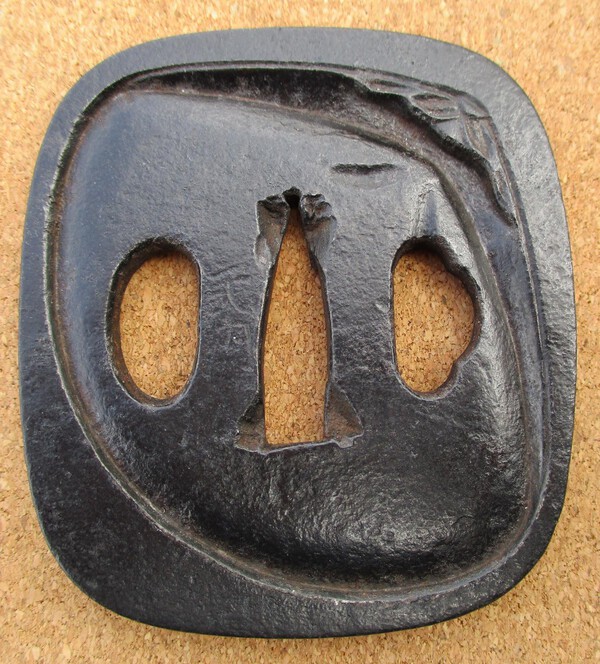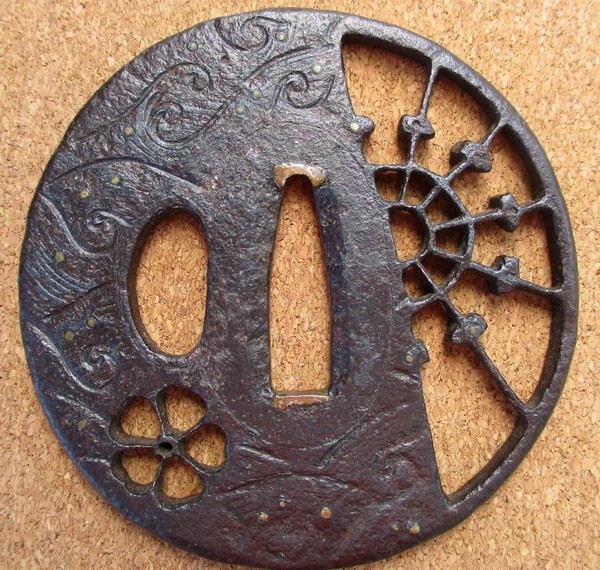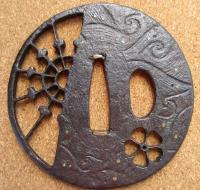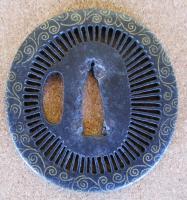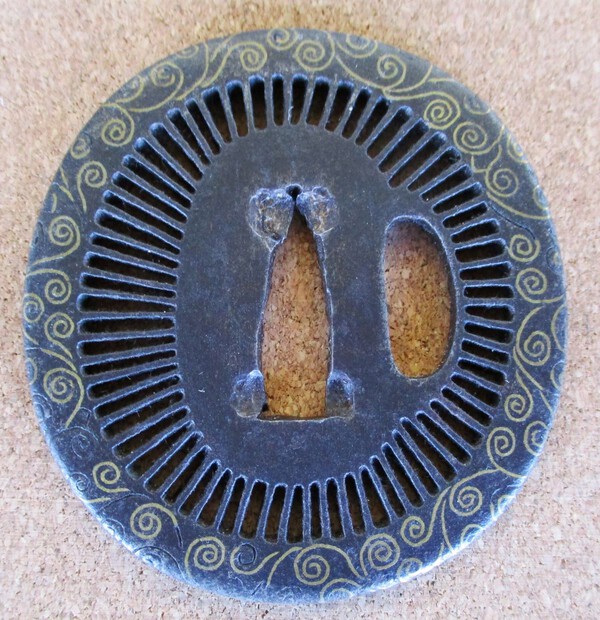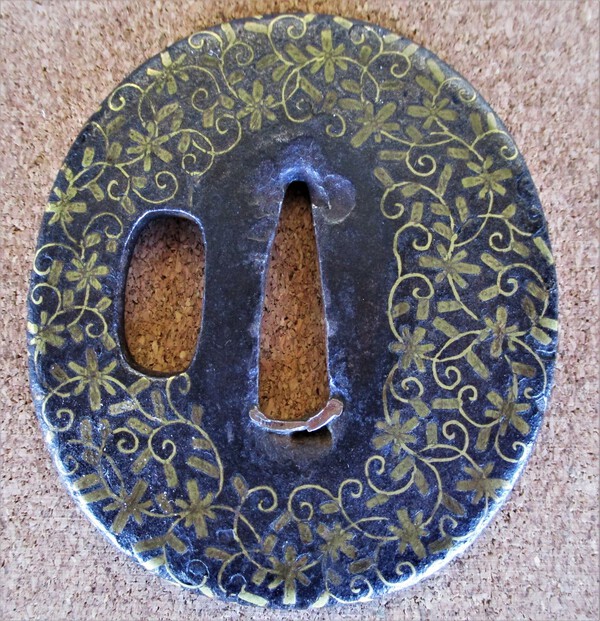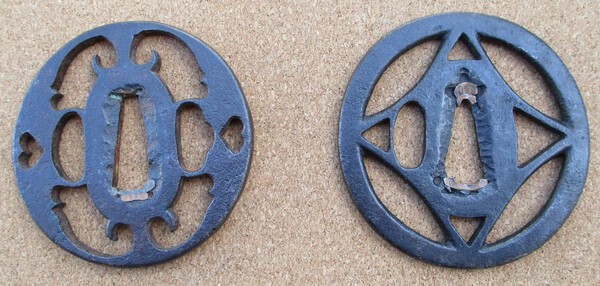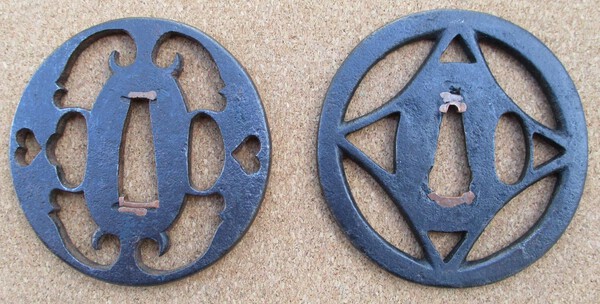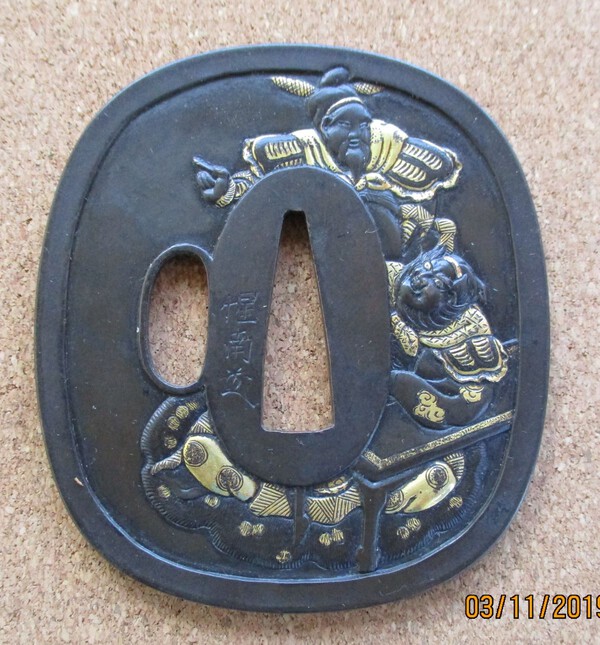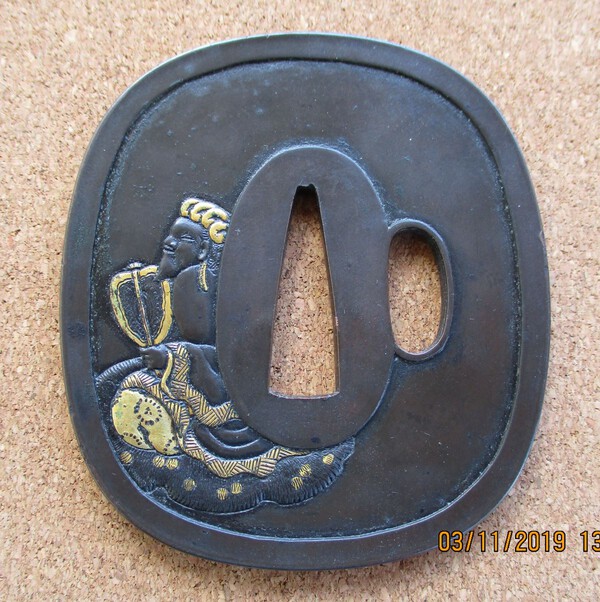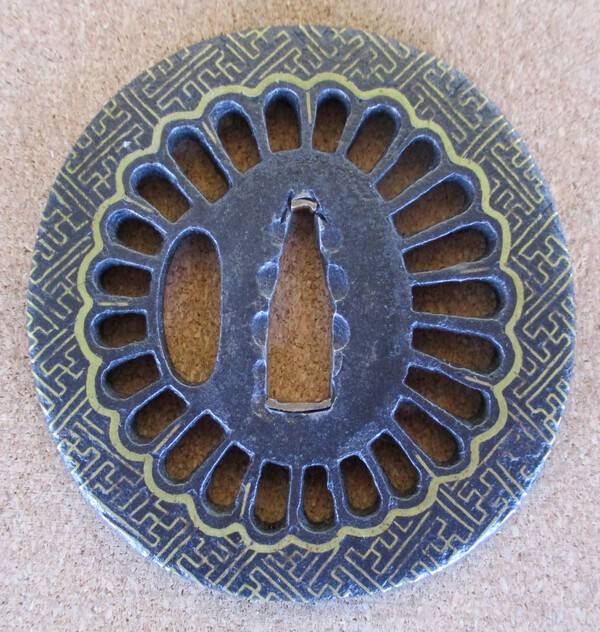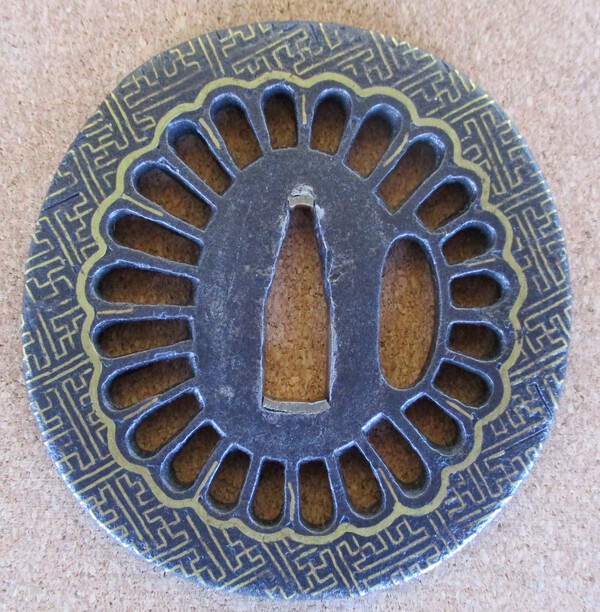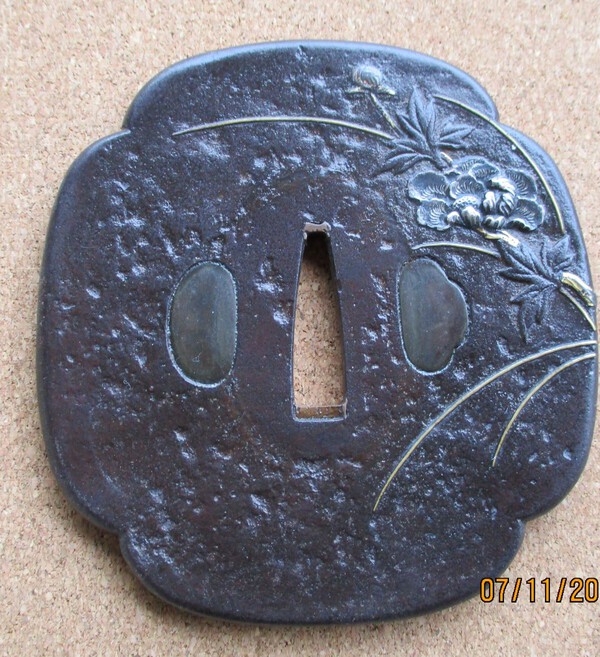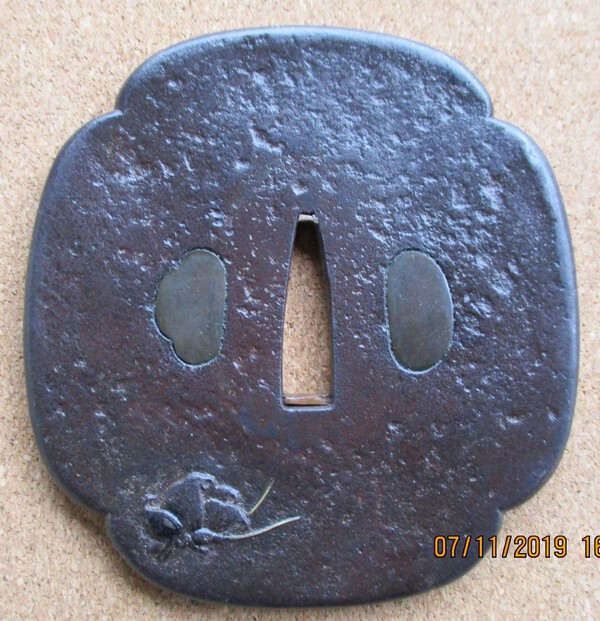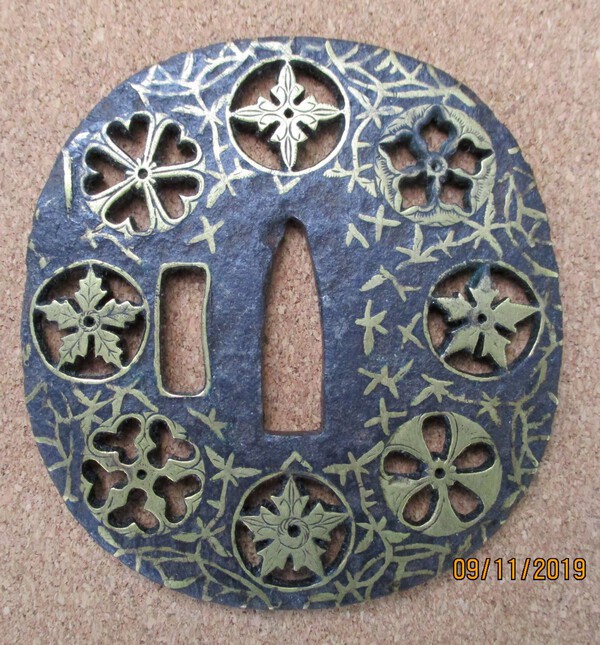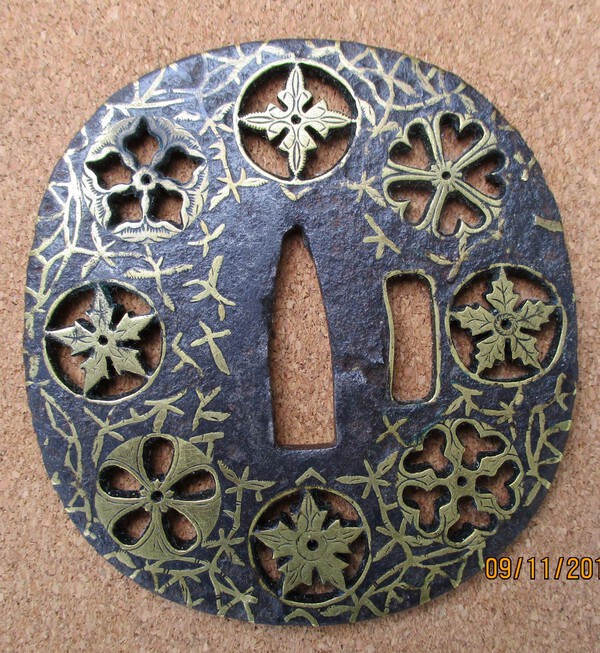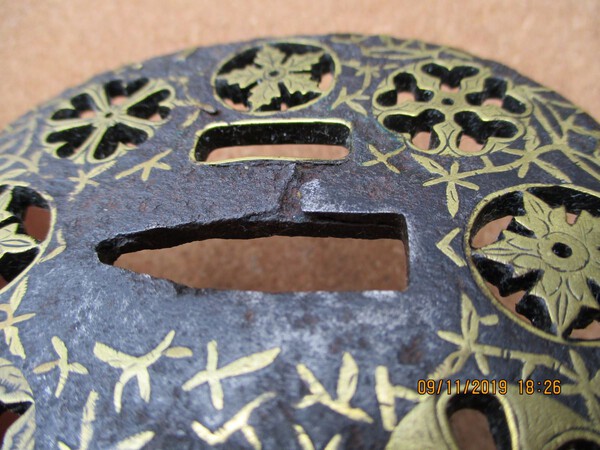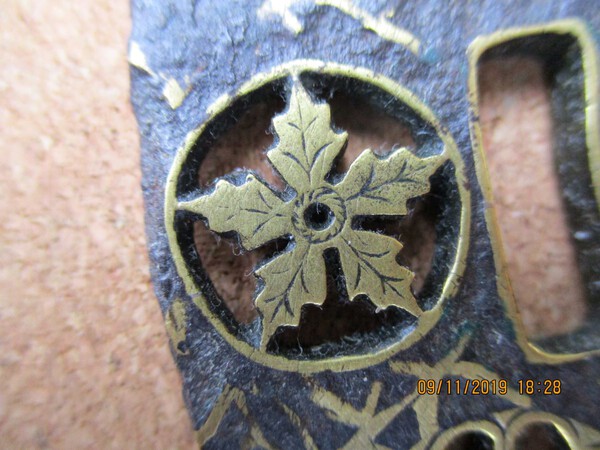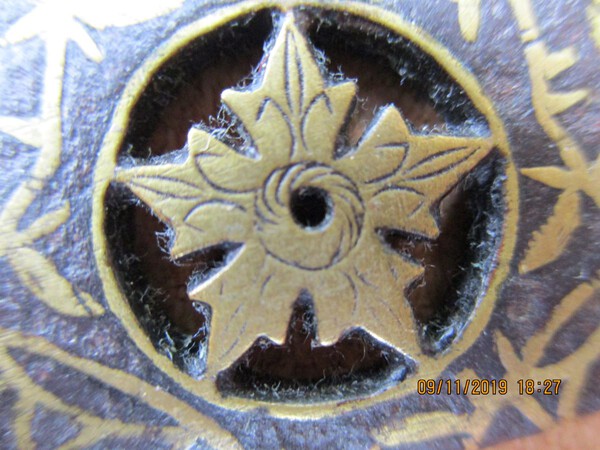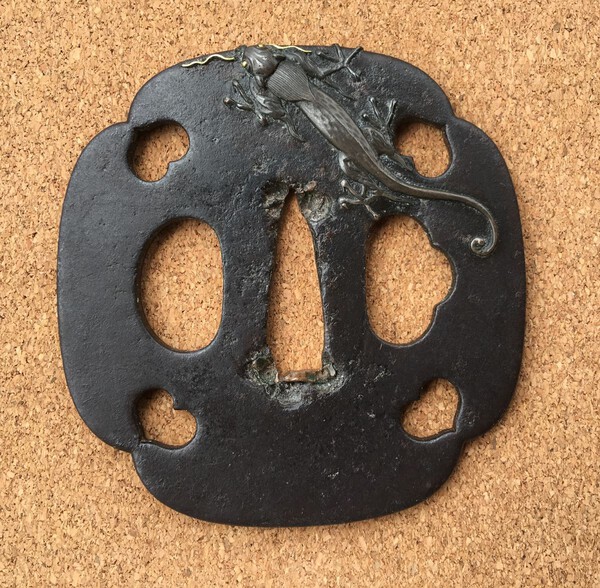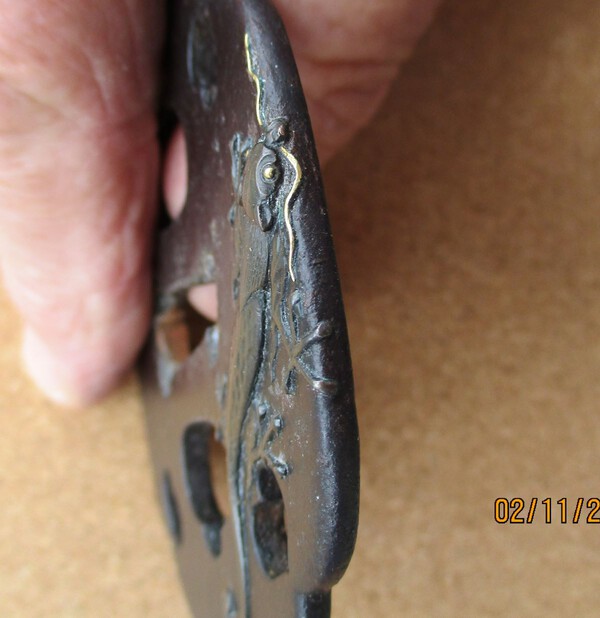Search the Community
Showing results for tags 'tsuba'.
-
I would very much welcome any thoughts or opinions about this small tsuba. I would think that it probably wouldn't appeal to a serious or advanced collector and can understand that but it has a couple of things about it that puzzle me so hope someone will respond. For a start the chiselling out of the 'hat shaped'? voids to create the eight pointed star shapes seem to my (not now very clear) eyes to be roughly done and without any filing to refine or finish their shapes. I would have thought that a proud tsuba smith would do that ? When trying to work out a period for it's use, some comparatively similar tsuba have been designated momoyama but the iron of this tsuba appears to be maybe not that old ? Then there is the Zogan- brass inlay. For something that looks somewhat insignificant I wonder who or why someone would go to the trouble- even though it is a simple and straight forward chevron pattern design except for the part circles at the top and bottom. For all that, I quite like it. ( 64 x 60 x .42) Maybe Owari School. Roger D
-
As per usual I would appreciate any and all comments members might like to offer . The first tsuba was the first I purchased but in fact is it a tsuba or just something that looks like a tsuba ? It measures 73 x 73 and very thin at the edge, 5mm at the centre area. Iron I presume, shakudo catfish and one gourd, silver the other. It appears competently made to my eyes but I just don't know what to make of it. The second tsuba is the last tsuba I purchased and I think it speaks for itself- I really like it.Am I correct : Saotome plate, later Kaga inlay. Azuchi- Momoyama era. 8.8 x 7.76 x .38 in measurement. If someone wants to be harsh in their comments, I can wear it . Roger d.
-
I bought this guard in Tokyo back in 2014 at an antique market, and lost the translation of the mei. Any help would be appreciated, I have seen similar designs assigned as Nishigaki would this be a good bet?
-
Just a general enquiry, but has anyone any evidence that any tsuba or fitting ever actually had 1,000 monkeys depicted on it? I have done some research and can't even find one with 100 on it - can't they count! As a fill in time exercise I have found one that looks very thick with monkeys and actually numbered them - not even close - 62 is a far cry from 100 and a long plane ride from 1,000. Any thoughts?
-
In the spare time available to many of us, here are two qite different tsuba for perusal : No. 1 A bronze plate with ishimi ground ( I think ).Military accoutrements- I just don't knowe what they are called and the names don't always stick in my memory for some reason. Measures 73 x 69 x .4 No.2 An iron plate, nicely chiselled to my mind though someone might say cast - I just don't think so. Dragons might be common but I am O.K with this one. Copper flower heads over laid - five on omote face, one on ura. Any comments would be welcome- I well realize they aren't anything special ( after seeing what else gets posted here ) ! Roger d
-
I have recently come across a series of tsuba - if that is what they are - other sources have termed them "asian export guards" as there is some dispute as to their origin. I have found at least thirteen examples, all slightly different and not cast. I have five examples in my own collection. One example not in my collection is listed as 'Bushu' but I have not found another attribution from that school. Another is described as Vietnamese based on an eight lobed design common in that country, however as I have found maru (round), four, five, six and eight lobed examples this reasoning would seem thin. (An eight lobed example currently on eBay.) I would welcome any comments or ideas as to their origin.
-
Well it has finally happened, my tsuba collection has come down with Covid-19 ! See the resemblance?
-
For example would a heavy shakudo tsuba change the balance point a lot more than one made of iron? Does a tsuba's weight really matter? How much of a difference does it make?
-
If you don't mind me saying so but I think this type of non-indigenous Tsuba show wonderful skilled design and workmanship. Imported into Japan from elsewhere in Asia and apparently copied at times by the locals ? I bother to say this because it appears not everyone shares this appreciation ? The undercutting of the vine tendrils (or sometimes waves ?) must have been tedious work, patiently having to drill and file, possibly sawing too and note how in one of the tsuba, the craftsman has cut a sort of ladder pattern on the mimi, all around the perimeter. Why would he have bothered unless he wanted to satisfy his craftsman instincts (or maybe his master told him to do it). I really like them and at times they can be purchased for remarkably low prices. There was one,maybe more, sold quite recently in the For Sale section of the NMB. Namban tsuba feature quite strongly in the 'Birmingham Museum of Art Gallery Tsuba Collection" as shown in Greville Cooke's recent publication ,about 45 of a total of around 600-( 35 of them with a cut tendril or wave theme ). I know these Tsuba have often been discussed on NMB so I trust my post is acceptable. Sizes: First one 71 x 69 x 5.5mm Second one 74.4 x 71.5 x 5mm Thank you and hope I haven't gone on too much (it could be senility). Roger Dundas
-
Hello once again and I would once more appreciate any comments or suggestions members might find time to make. The tsuba measures 73 x 70 x 5.2 mm in the centre. I think it is delicately made- if I can say that using a non-technical term. Mito school ? Mid to late 1800s ? Thank you again, Roger d.
-
I would very much be interested in any information that anyone could offer me about this tsuba. I'm not sure why I bought it because I don't particularly like it. Possibly because I thought a fair bit of work had gone into it and the price seemed cheap- $ 170 US in 2015, (but maybe this wasn't cheap ?) These are among the things I don't know. 73 x 70 x 6mm and quite heavy. Attractive black colour. Roger d.
-
I wonder if any member would like to comment about this rough, neglected piece and it's relative worth (if any) in a collection ? size 80 x 7.9 x 6mm Thank you, Roger d.
-
Maybe no one will be looking during this Christmas break but once more can I ask for an opinion on these two pieces plus on Soten made tsuba generally. I get the impression that they are not(?) always held in high regard but for my interest these are very satisfying for workmanship and condition. I notice that the Compton catalogues have few examples so suppose he wasn't in love with the genre ? I can handle any brutal comments that might come this way. Measurements are 81 x 75 and 80 x 77mm roger d
-
I was recently gifted an antique iron Tsuba from a friend’s grandfather’s antique collection. It has a very similar appearance to one seen on the internet, listed as Kaga Myochin. My friend’s grandfather bought it in April 1986 from an Oikawa san and the description also mentioned 花刀無井 Hanai Katana. Can anyone help me with any identification and thereby history of my gift? I can post pictures if possible on this thread Thanks S.Merry
-
Have had for a few years now and have seen a couple of others offered for sale of pretty much identical 'shell' design ,the only differences being the chiselled maker's name- the others seeming to be more extensive. I was wondering if someone would care to offer an opinion as to the authenticity of this tsuba. 73 x 67 x 5 mm. Thick and heavy. Seems good iron to me.
-
I have seen two or three examples of this design, one on Shibuiswords- tsuba and one on NMB on September 27, 2006- a long while back.. 70 x 69 x 4mm. Late muromachi- early edo maybe, that's if the darn thing is for real which I believe/hope it is. For all that , I'm pleased to have it if it is real. Roger D
-
Pics of the 2 tsuba meant to be posted yesterday. The spoked tsuba is 67 x 63 x 4mm. There was a similar but slightly larger example sold earlier this year (or late last year) by Gary Murtha I think. The tsuba with tendrils, leafs (should that be leaves?)and flowers is 68 x 60 x 5mm. Does anyone think the brass colors of the vines differ from that of the leafs and flowers ? I can't decide myself and would like know what you think. I would welcome comments also as to the relevance of a tsuba's size to collectors if any member would care to comment. Personally I particularly like these two pieces and the fact that they would be mounted on smaller swords is of no issue with me but should I think differently ? A further observation is the amount of work the craftsmen have gone to- the floral inlay for one and the cutting of the spoke apertures as well as the inlay on the other. I think Ford Hallam remarked that (jewellers type ?) piercing saws didn't get to Japan before the end of the 1800s which I presume post dates this work ? So how did the Tsuba smith cut out the spokes ? Trusting you are all OK with my questions and thank you. Roger D
-
I had thought that a modern tsuba maker probably wouldn't bother with double or triple sekigane fillers or go to much trouble with nakago ana modifications especially if the replica tsuba was of not much consequence- so I bought these two for little money as examples of their type. I quite liked them for that reason but now having read some of the recent posts I wonder just where they fit in and welcome your thoughts if you would care ? The Owari tsuba is 65 x 64 x 5 mm The Shippo(mon) Sukashi is 68 x 66 x 3mm Thanks....Roger Dundas
-
Not a lot that I know- metal is shibuichi possibly. Carefully shaped figures- faces and hands. Good condition. 72 x 63 x 3.5 mm
-
Described as- KOSHI SUKASHI UME KARAKUSA ZU decoration, JISUKASHI . GIN ANDSHINCHU ZOGAN technique. I think I got that correct. 74 x73 x 3.6mm One question I have is about the 2 missing silver flower petals on the omote face. Does anyone have an opinion as to whether this might have been done so as make it match the 3 silver petals on the ura face. Is that a ridiculous concept or is it possible but who would know ? Their removal is quite complete. Another question is regarding a period of manufacture please ? Thanks in anticipation. Roger Dundas
-
It seems that many of these pieces manage to lose a bit of inlay over the years- this example has done better than many. I enjoy the fine, accurate inlay- swastika pattern is it. It doesn't go over onto the rim. 8 x7.5 x 5mm
-
Firstly- are the NMB members comfortable with me posting requests for opinions as I've been doing ? That is - too frequently ? The question for this one is the approx. date- is it c1850s ? An iron plate with overlaid ,silvered peonie rose (silvered copper possibly?). A butterfly on the ura face- is that how it is described. 84 x 79 x 4.7 mm Good condition. Has been mounted. I quite like it. Roger dundas
-
Showing wear and tear of the years, mon inlays appear similar work to those inlays used in tsuba posted by Benjamin,(NMB) September 10, 2019 ex Paris flea market- a fine example. Also similar to Heianjo tsuba in Ashmolean museum bequeathed by Sir Arthur H Church in 1915- EAX 10168 (Oxford University). Plate showing pronounced delamination in hitsu ana area. 8 x 76 x 4mm Roger Dundas
-
Looking forward to any and all comments re this tsuba. To me the carving, casting and attachment of the figure is excellent but the overall effewct is somewhat spoiled by the ugly hitsu ana excavations- does this matter ? 74 x 71 x 4 cm ( after all these years I still find metrics a bit confusing after being raised on feet and inches )

